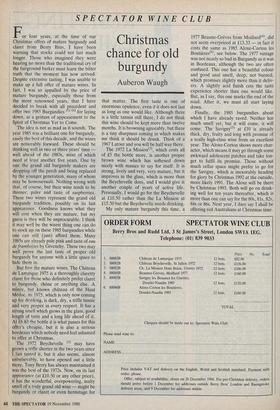SPECTATOR WINE CLUB
Christmas chance for old burgundy
Auberon Waugh
The idea is not as mad as it sounds. The year 1985 was a brilliant one for burgundy, easily the best of this decade, and the wines are noticeably forward. These should be drinking well in two or three years' time well ahead of the 1983s, most of which need at least another five years. One by one the grand old burgundy makers are dropping off the perch and being replaced by the younger generation, many of whom may be homosexuals. Nothing wrong with that, of course, but their wine tends to be thinner, paler and taste of raspberries. These two wines represent the grand old burgundy tradition, possibly on its last appearance. Goodness knows what they will cost when they are mature, but my guess is they will be unprocurable. I think it may well be the wisest thing one can do to stock up on these 1985 burgundies while one can still (just) afford them. Many 1985s are already pale pink and taste of eau de framboises by Givenchy. These two may well prove the last taste of proper old burgundy for anyone with a little space to hide them in.
But first the mature wines. The Château de Lamarque 1975 is a thoroughly claretty claret for those who definitely prefer claret to burgundy, rhone or anything else. A minor, but known château of the Haut Medoc, its 1975, which is only now coming up for drinking, is dark, dry, a trifle tannic and very proper in every respect. It has a strong smell which grows in the glass, good length of taste and a long life ahead of it. At £6.83 the bottle it is what passes for this offer's cheapie, but it is also a serious bordeaux which nobody need feel ashamed to offer at Christmas.
The 1972 Beychevelle (2) may have grown a trifle shorter in the two years since I last tasted it, but it also seems, almost unbelievably, to have opened out a little more. Tony Berry has always maintained it was the best of the 1972s. Now, on its last appearance (at £10.50 or any other price), it has the wonderful, overpowering, malty smell of a truly grand old wine — might be burgundy or claret or even hermitage for that matter. The first taste is one of enormous opulence, even if it does not last as long as one would like. Although there is a little tannin still there, I do not think this wine should be kept more than twelve months. It is browning agreeably, but there is a tiny sharpness coming in which makes me think it should be drunk. Think of a 1967 Latour and you will he half way there. The 1972 La Mission(3), which costs all of £5 the bottle more, is another proper brown wine which has softened down nicely with masses to say for itself. It is strong, lively and very, very mature, but it improves in the glass, which is more than the Beychevelle does, and I would give it another couple of years of active life. Personally, I would go for the Beychevelle at £10.50 rather than the La Mission at £15.50 but the Beychevelle needs drinking.
My only mature burgundy this time, a 1977 Beaune-Greves from Moillardo), did not seem overpriced at £13.33 — in fact it costs the same as 1985 Aloxe-Corton les Boutieres(6), see below. The 1977 vintage was not nearly so bad in Burgundy as it was in Bordeaux, although the two are often confused. This one has a beautiful colour and good anal smell, deep, not burned, which promises slightly more than it deliv- ers. A slightly acid finish cuts the taste experience shorter than one would like. But, as I say, this one marks the end of the road. After it, we must all start laying down.
Finally, the 1985 burgundies about which I have already raved. Neither has much smell yet, but it will come, it will come. The Savigny(5) at £10 is already thick, dry, fruity and long with promise of a really high-class wine from an excellent year. The Aloxe-Corton shows more char- acter, which means it may go through some awkward adolescent patches and take lon- ger to fulfil its promise. Those without much cellar space might prefer to go for the Savigny, which is inexorably heading for glory by Christmas 1992 at the outside, more likely 1991. The Aloxe will be there by Christmas 1993. Both will go on drink- ing well for ten years thereafter, which, is more than one can say for the 80s, 81s, 82s, 84s or 86s. Next year, I dare say I shall be offering red Australians at Christmas time






















































 Previous page
Previous page